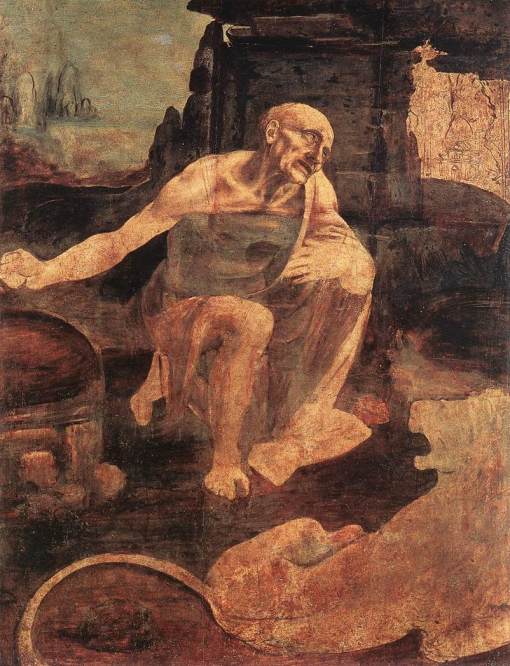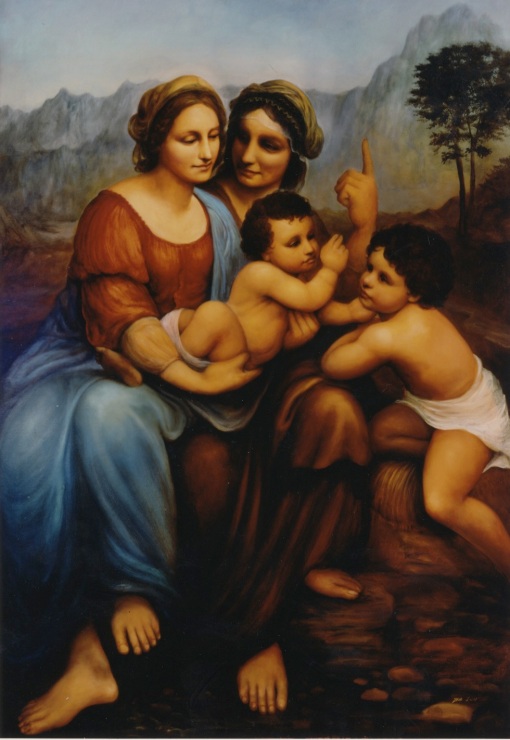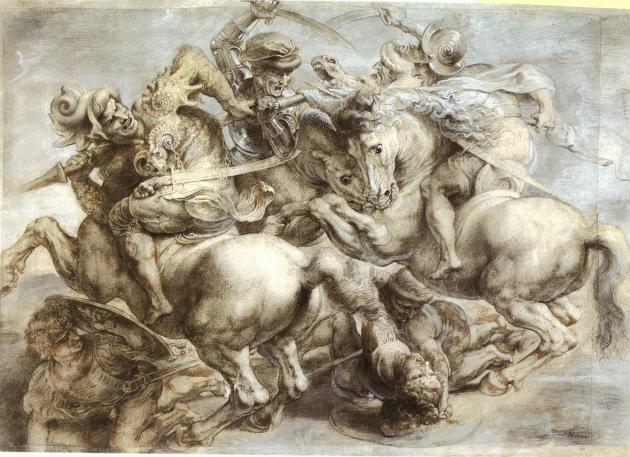Finishing Da Vinci
March 25, 2012 9 Comments
 Few people are as famous as Leonardo da Vinci. His paintings have become icons of civilization, his notebooks the quintessential expression of the creative and scientific mind. He is who we mean when we say ‘Renaissance Man.’ But he had a fatal flaw. For all his artistic and inventive genius, he rarely finished anything. Even his most famous work, the Mona Lisa, was never ‘completed.’ Vasari, a contemporary of Leonardo’s, wrote in his biography of Leonardo (in Lives of the Most Eminent Italian Architects, Painters, and Sculptors, 1550), that “Leonardo undertook to execute, for Francesco del Giocondo, the portrait of Mona Lisa, his wife; and after toiling over it for four years, he left it unfinished.”[1]
Few people are as famous as Leonardo da Vinci. His paintings have become icons of civilization, his notebooks the quintessential expression of the creative and scientific mind. He is who we mean when we say ‘Renaissance Man.’ But he had a fatal flaw. For all his artistic and inventive genius, he rarely finished anything. Even his most famous work, the Mona Lisa, was never ‘completed.’ Vasari, a contemporary of Leonardo’s, wrote in his biography of Leonardo (in Lives of the Most Eminent Italian Architects, Painters, and Sculptors, 1550), that “Leonardo undertook to execute, for Francesco del Giocondo, the portrait of Mona Lisa, his wife; and after toiling over it for four years, he left it unfinished.”[1]
But at least the Mona Lisa, The Last Supper and Lady with an Ermine look done (regardless of their actual state). This is not so with four other works by da Vinci which are clearly nowhere near finished, and it is these four paintings – The Adoration of the Magi, St Jerome in the Wilderness, The Virgin and Child with St Anne and St John the Baptist, and The Battle of Anghiari – that inspired a project to re-create these paintings in their final form. Audacious, yes, but the new paintings are true to the original compositions, and there was no pretense that the new paintings would be as da Vinci would have painted them. The goal was simply to see what these works might look like in a completed state. The project started in 1995 (with The Battle of Anghiari) and ended in 2000.
The artist, David Jean, is an internationally recognized painter whose works hang in numerous important collections ranging from the Vatican to the Pentagon. More about Jean can be found at his website AngelSpeak.
The Adoration of the Magi
The first work is The Adoration of the Magi. This painting was commissioned by the monks of San Donato a Scopeto, Florence, in 1481. The monochromatic underpainting that da Vinci left unfinished hangs today in the Uffizi. It is a famous scene where the the three wise men (traditionally Balthazar, Caspar and Melchior), bring gifts (gold, frankincense and myrrh) to the baby Jesus. In the event, da Vinci left for Milan in 1482 and never completed it (the commission was subsequently given to Ghirlandaio).
It is a complicated painting, with scores of people surrounding the infant Jesus, against a backdrop of crumbling buildings and men fighting on horseback. A perspective study for the painting by da Vinci is famous in its own right and can be seen here: Study for the Adoration of the Magi. It shows how carefully da Vinci planned out the composition. The original (oil on wood) is 246 cm x 243 cm (97 in x 96 in). David Jean’s oil on canvas is 152 cm x 152 cm (60 in x 60 in). [2]
St Jerome in the Wilderness
The next work is da Vinci’s painting of St Jerome, c1480. In the legend, St Jerome retreats to the desert to live like a hermit. In his hand he holds a rock which he beats himself with to overcome the hallucinations that beleaguer him. A lion sleeps at his feet, his faithful companion since he pulled a thorn from its paw.
As can be seen in the image of the original, the head was, at some point, cut out from the larger painting. Popular lore has it that in the early nineteenth century Cardinal Fresch found both parts (one being used as a table top; the other a door stop), and reassembled them, but this sounds too fantastic to be true. Nevertheless, the two parts came back together somehow and the painting is now in the Vatican Museums in Rome. The original is 103 cm x 75 cm (41 in x 30 in). David Jean’s re-creation is 100 cm x 75 cm (40 in x 30 in).
The Virgin and Child with St Anne and St John the Baptist
The third unfinished work is known as The Virgin and Child with St Anne and St John the Baptist (1499-1500 or 1506-08). It exists today only as a cartoon, now in the National Gallery. Like the Adoration, it too, is a complicated composition. It is not clear why da Vinci never completed this work. The original is 141.5 cm x 104.5 cm (55.7 in x 41.2 in). The David Jean painting (oil on canvas) is 152.4 cm x 101.6 cm (60 in x 40 in).
Done in charcoal and white chalk on paper, it is similar in many ways to another da Vinci painting, Virgin and Child with St Anne (c1508), which is finished (or at least near-finished), and is now in the Louvre (similar colors were used by Jean, see the painting here).

Cartoon of The Virgin and Child with St Anne and St John the Baptist, now in the National Gallery, London.
The Battle of Anghiari
The last unfinished da Vinci piece is The Battle of Anghiari, 1505. Da Vinci painted this work (or started to) on a wall in the Palazzo Vecchio in Florence. On the opposite wall, Michelangelo was to paint the Battle of Cascina. Neither finished: Michelangelo was called to Rome by the Pope; da Vinci tried a new paint but the colors ran together before the paint could dry, ruining the work, and he abandoned it.
The central scene was a battle for the standard and a copy was drawn by Peter Paul Rubens in 1603 from an engraving which may have been made from the original painting or a study for it by da Vinci. Rubens’ copy captures the fury of close-in fighting – even the horses are terrified.
The wall was 54 feet long and 21 feet high, although the central panel would have been only a fraction of the total length. David Jean’s painting is 182.8 cm x 152.4 cm (72 in x 60 in).
The room in the Palazzo Vecchio that housed the painting was subsequently restructured and new walls put up, but work by Maurizio Seracini indicates da Vinci’s original fresco may be on a wall behind the wall. Indeed, very recently (December 2011), Seracini and his team drilled small holes in the wall (through unimportant or restored parts of the Vasari painting on the outer wall), and discovered pigment on the inner wall similar to pigments found in glazes on other works by Leonardo. Thus, it is possible The Battle still exists, though in what state remains to be seen.
- Central scene of the Battle by Rubens, now in the Louvre.
[1] Giorgio Vasari: “Life of Leonardo da Vinci”, in Lives of the Most Eminent Painters, Sculptors, and Architects, translated by Gaston DeC. De Vere, (London: Philip Lee Warner, 1912-1914). In the same work, Vasari claims Leonardo never finished the face of Christ in The Last Supper.
[2] The painting of the Adoration by David Jean has been selected by Harvard Business School to appear in a digital work called The Progress Principle, which focuses on creativity and which cites the value in copying old master paintings.







I very much enjoy Leonardo’s works. The pieces done by david jean are nice but some of these appear to have slight modified backgrounds, and the color is wrong for the period. It is nice work. Excellent work in fact. But to me, Leonardo would have wanted more monotones. I find sometimes my most unfinished work is my best.
Is there any way to purchase a six by six foot (or thereabouts) of either the da Vinci drawing (preferred) or the David Jean painting of the Adoration of the Magi. I need something that is
reasonably priced for a play based on the Adoration of the Magi.
Thanks, Michael Ridenour
The Virgin and Child with St Anne and St John the Baptist, in the National Gallery, London is My favourite drawing EVER, next to The Battle of Anghiari, 1505. I want, no, I NEED, good reproductions/posters of these – any suggestions as to where I might find them?
I admire the patience it must have taken to paint the adoration. Everyone has wished to see it! My blog is DaVinciReimagined.wordpress.com
You accidentally took the rock out of st. Jerome’s hand. He is depicted with a rock by Titian, Pantormo, Albrecht Bouts, El Greco, Botticelli, Perugino, Bronzino, di Sano, Lippi, Patinir, the list goes on and on. The reason he holds a rock is because he is beating his chest with it.
Reblogged this on I'sblog and commented:
Neat site, history
Reblogged this on Howard Bosler Artist and commented:
Extremely interesting article on the unfinished works of Da Vinci. I have always desired to do this myself considering the way I study artists by doing reproductions of their work.
Amazing post it’s great to get a better sense of what these pieces would have looked like completed. David Jean is an amazing painter and I think he has done every one of these artworks incredible justice. Thanks for the post I’ll be re blogging this one.
Reblogged this on The Fine Art of J Glover and commented:
Incredible post that shows what these finished Da Vinci artworks could have looked like, the artist responsible, David Jean has done them a lot of justice.